
HPU2. Nat. Sci. Tech. Vol 03, issue 03 (2024), 10-19.
HPU2 Journal of Sciences:
Natural Sciences and Technology
Journal homepage: https://sj.hpu2.edu.vn
Article type: Research article
Received date: 03-5-2024 ; Revised date: 24-7-2024 ; Accepted date: 06-9-2024
This is licensed under the CC BY-NC 4.0
10
An ab initio calculation on the structural, electronic and magnetic
properties of Ni-doped Bi
0.5
Na
0.5
TiO
3
Quoc-Van Duong
a
*
, Anh-Duong Nguyen
a
, Cao-Khang Nguyen
a
, Ngoc-Anh Nguyen Thi
a
,
Chinh-Cuong Nguyen
a
, Duc-Dung Dang
b
, Tien-Lam Vu
b
, Minh-Thu Le
a
a
Hanoi National University of Education, Hanoi, Vietnam
b
Hanoi University of Science and Technology, Hanoi, Vietnam
Abstract
The first principle calculation was employed to investigate the formation energies and structural,
electronic, and magnetic properties of intrinsic and Ni-doped sodium bismuth titanate Bi
0.5
Na
0.5
TiO
3
(BNT). The obtained formation energies indicate that Ni atoms prefer to dope into Bi-sites in the lattice
of BNT while the calculated band structure shows that the doping leads to the emergence of new mid-
gap energy states in the bandgaps, reducing the bandgap value of doped materials. The PDOSs reveal
that Bi-6p, O-2p and Ti-3d contribute major parts in BNT valence and conduction bands, while the Ni-
3d and 4s play the main roles in the formation of new mid-gap states. The spin-resolved density of
states, the integrated spin densities and the charge distributions suggest that all doped models exhibit
magnetic behavior, mainly due to the interaction of Ni, O and Ti atoms. The study method of this
research can be applied to predict new properties of BNT-based materials.
Keywords: BNT, DFT, Ni-doped, electronic structure, magnetic property
1. Introduction
Since discovered by Smolenskii et al [1], [2] in the 1960s, lead-free ferroelectric Bi
0.5
Na
0.5
TiO
3
(BNT) has become one of the most studied materials worldwide. The ferroelectric behavior of BNT is
comparable to that of Pb(Zr,Ti)O
3
(PZT) with large remnant polarization of about 40 μC/cm
2
and large
coercive field of around 70 kV/cm [3]. Recently, the discovery of weak ferromagnetic properties at
room temperature [4] confirms that BNT can replace PZT in many application areas, especially in the
field of smart electronic devices, producing sustainable and environment friendly products and protecting
human health [5]. However, the application of BNT is limited by its low magnetization at room
*
Corresponding author, E-mail: vandq@hnue.edu.vn
https://doi.org/10.56764/hpu2.jos.2024.3.3.10-19

HPU2. Nat. Sci. Tech. 2024, 3(3), 10-19
https://sj.hpu2.edu.vn 11
temperature [4], [6], approximate 1.0 memu/g, preventing its usage in technology and real-life
applications. This limitation has been tried to overcome via different experimental methods: doping with
magnetic element likes Fe [7], Co [8], Mg [9]; forming solid solutions or compositing with other
magnetic materials such as CoFe2O4 [10], [11], BiFeO3 [12], BaNiO3, CaNiO3; MgNiO3 or SrNiO3
[13]–[16]; or hybridization of both doping and compositing [12]. The obtained results show that doping
with transition elements can clearly improve the magnetic behavior of modified BNT compared to
intrinsic material.
However, the origin of the magnetic properties of doped BNT is not clearly explained by both
experimental and theoretical views. Thanh et al [17] show that the room temperature ferromagnetic
behavior of BNT can be origin from the enhance of oxygen vacancies when Cr cations substituted into
Ti-sites in BNT lattice. For Co-doped BNT, while Wang et al [4] prove that the room temperature
magnetism of modified BNT arose from Co clusters forming during the crystallization of matter, Dung
et al [18], [19] suggest that the origin of this magnetic behavior is the random distribution of Co cations
in the lattice of BNT. However, recent studies indicate that the super exchange interactions between
transition ions and oxygen vacancy (Ov) such as Fe3+-Ov-Fe3+ [7], Ni2+/3+-Ov-Ni2+/3+ [13] should be
considered as the origin of ferromagnetism of Fe- or Ni-modified BNT. In theoretical studies, Dung et al
[13]–[16] suggest that the doping of Ni atoms into both Bi-sites and Na-sites in the lattice of BNT
clearly influenced the electronic properties of host BNT, inducing the magnetic behavior of materials.
On the other hand, Ju et al [20] using VASP to prove that magnetic moment can be induced when
transition metal atoms (V, Cr, Mn, Fe or Co) incorporate into Ti-sites instead of Bi- or Na-sites.
However, when doped into BNT lattice, Ni atoms can substitute into different position: Bi-sites, Na-
sites, Ti-sites, and interstitial sites. The favored doping positions of Ni atoms are not confirmed, so is
the origin of the magnetic behavior of Ni-doped BNT.
In this research, a complete theoretical investigation on the origin of magnetic properties of Ni-
doped BNT has been performed and analyzed using first principle calculation. Models of possible
doping positions of Ni atoms into BNT lattice have been built and investigated to carry out the favorited
doping sites, confirming the origin of magnetism of Ni-doped BNT. The method used in this research
can be applied to the other doped BNT materials, concluding the causes of the improvement of magnetic
properties of doped BNT.
2. Computational methods
Figure 1. The models of a) intrinsic and Ni-doped BNT at b) Bi-sites, c) Na-sites, d) Ti-sites and
e) interstitial sites.

HPU2. Nat. Sci. Tech. 2024, 3(3), 10-19
https://sj.hpu2.edu.vn 12
In this research, a unit cell of intrinsic BNT containing 3 Bi atoms, 3 Na atoms, 6 Ti atoms and 18
O atoms (labelled as BNT, as shown in Figure 1a) was used to study physical properties of material. To
investigate the effects of Ni doping on the physical properties of BNT, 4 Ni-modified models were
created. Three models of substitutional N-doped supercells were constructed and labelled as B(Ni)NT,
BN(Ni)NT and BNT(Ni) for the case of Ni atoms doped into Bi-sites, Na-sites and Ti-sites,
respectively; the interstitial Ni-doping model (labelled as BNT+Ni) was constructed by embedding one
Ni atom into the interspace of BNT; as shown in Figure 1b-e.
The Cambridge Serial Total Energy (CASTEP) [21], [22], a DFT-based calculation package, was
used to investigate the structural, electronic and magnetic properties of intrinsic and Ni-doped BNT
materials. The exchange-correlation interactions were described using the Generalized Gradient
Approximation (GGA), parameterized with Perdew-Burke-Erzernhof functional [23], [24]. The ultrasoft
pseudopotential introduced by Vanderbilt [25] was used to describe the interactions between the core
and valence electron: 6s26p3 for Bi, 3s1 for Na, 3d24s2 for Ti, 2s22p4 for O and 3d24s2 for Ni. The k-
points grid, based on Monkhorst-Pack scheme [26], used to calculate in the Brillouin zone was set by
5×5×2 for all models. A cutoff energy of 410 eV has been used for band structure calculation. The
calculation processes converge when the change in total energy reaches 5×10−6 eV/atom; and the
corresponding tolerances for force, stress and displacement were 0.01 eV/Å, 0.02 GPa and 0.005 Å,
respectively.
3. Results and discussion
3.1. Formation energies
In general, a more stable and formable model has negative and large magnitude formation energy
whereas the positive values indicate that the materials are synthesizable but nonstable. The formation
energy 𝐸mod of defective BNT models can be calculated as follows [27]:
Emod = Etot (models) – Etot (pure) - m
Ni + n
Bi + p
Na + q
Ti
Etot (models) and Etot (pure) are the total energies of Ni-doped and intrinsic BNT models; 𝜇Ni, 𝜇Bi,
𝜇Na and 𝜇Ti represent the chemical potentials of the Ni, Bi, Na and Ti atoms, respectively; 𝑚, n, p and q
are the numbers of doped Ni atoms and removed Bi, Na and Ti atoms in the models, listed in Table 1.
Table 1. Values of doped Ni atoms (𝑚), removed Bi atoms (𝑛), removed Na atoms (𝑝) and removed Ti atoms (𝑞)
for intrinsic and defective BNT models.
Models BNT B(Ni)NT BN(Ni)T BNT(Ni) BNT+Ni
m 0 1 1 1 1
n
0
1
0
0
0
p
0
0
1
0
0
q
0
0
0
1
0
The formation energies of defective BNT models were calculated and listed in Table 2. It is known
that a smaller formation energy indicates a more stable material, while a higher formation energy
suggests that the sample is more difficult to form. It can be seen that BNT(Ni) model has the highest
formation energy while B(Ni)NT model has the lowest one; the formation energies of both BN(Ni)T
and BNT+Ni models are similar, significantly smaller than that of BNT(Ni) but larger than B(Ni)NT’s.
The results show that when incorporated into BNT lattice, Ni atoms prefer to replace into Bi-sites rather
than the remains. The formation energies of BN(Ni)T and BNT+Ni suggest that the Na-sites or
interstitial sites can be taken by Ni atoms at higher doping concentration.

HPU2. Nat. Sci. Tech. 2024, 3(3), 10-19
https://sj.hpu2.edu.vn 13
Table 2. Formation energies of Ni-doped BNT models.
BNT B(Ni)NT BN(Ni)T BNT(Ni) BNT+Ni
Formation Energy (eV)
3.0818
4.1299
8.0630
4.0554
3.2. Structural properties
Table 3. Lattice constants of intrinsic and Ni-doped BNT models.
Models a = b (Å) c (Å) Total Energy (eV)
BNT
5.4939
13.8345
-
21882.4689
B(Ni)NT
5.3905
13.8668
-
23082.6532
BN(Ni)T
5.4662
13.8705
-
21928.4755
BNT(Ni)
5.4659
13.7139
-
21625.6576
BNT+Ni
5.5393
14.2491
-
23232.7853
Table 3 shows the optimized lattice constants of unit cells of intrinsic and Ni-doped BNT models
calculated using CASTEP; the trend of changes in lattice constants and total energies of models was
displayed in Figure 2. The achieved lattice constants of BNT models are a = b = 5.4939 Å and c =
13.8345 Å, in good agreement with calculations and experiments [28], [29] and other theoretical studies
[14]. Figure 2a shows that the doping of Ni atoms as a substitution decrease the a and b values of BNT
unit cell, despites of doping sites. This is the results of smaller ionic radius of Ni (0.69 Å) compared to
that of Bi (0.76 Å), Na (1.18 Å) or Ti (0.74 Å) [30]. For the interstitial doping, the incorporation of Ni
atoms into the interspace of BNT lattice leads to an expansion of unit cells, resulting in larger lattice
constant of 5.5393 and 14.2491 Å.
Figure 2. a) Lattice constants and b) total of intrinsic and defective BNT mosdels.
Figure 2b shows that B(Ni)NT and BNT+Ni have the lowest calculated total energies, while
BNT(Ni) has the highest total energy per unit cell. The results indicate that both B(Ni)NT and BNT+Ni
are stable models, and BNT(Ni) is the least stable one, suggesting that when Ni atoms are doped into
BNT, B(Ni)NT and BNT+Ni are more formable than BN(Ni)T and BNT(Ni). By comparing these
results with the formation energies shown in Table 1, it can be predicted that Ni atoms tend to substitute
into Bi-sites or interstitial sites when doped into BNT lattice at low concentration and into both Bi-sites
and interstitial-sites at high concentrations.
3.3. Electronic structures
Figure 3 illustrates the calculated band structures and partial density of states of intrinsic and Ni-
modified BNT models. Figure 3a shows that BNT is a direct bandgap material with bandgap value of
2.86 eV, the highest energy states in the valence band and the lowest energy state in the conduction

HPU2. Nat. Sci. Tech. 2024, 3(3), 10-19
https://sj.hpu2.edu.vn 14
band both occurs at the center point gamma G of Brillouin zone. It can be seen that the Fermi level in
BNT is located just on the top of valence bands, suggesting that the material behaves as a p-type
semiconductor. Figure 3b-e suggest that the incorporation of Ni atoms into the lattice of BNT creates
new mid-gap states in the band gap of host material, leading to a decrease of bandgap and shifting the
absorption edge of BNT to the longer wavelength zone. The doping of Ni atoms into the BNT lattice
also shifted the Fermi levels to the top of valence bands in B(Ni)NT and BNT(Ni) models, opposition
with the case of BN(Ni)T and BNT+Ni, whereas the Fermi level located just below the conduction
bands. The location of Fermi levels suggest that B(Ni)NT and BNT(Ni) behave as p-type
semiconductors, while BN(Ni)T and BNT+Ni are n-type semiconductors, consistent with Linh et al [31].
It can be observed that the Fermi level is at the top of valence band for BNT, BNT(Ni) and BNT+Ni but
it is located in the mid-gap levels for B(Ni)NT and BN(Ni)T; originating from the shifting of Fermi
level due to the incorporate of Ni atoms into doping sites. In general, all the doped Ni atoms creates new
mid-gap levels in the bandgap of intrinsic BNT. However, if doping into Bi/Na sites gives additional
electron to the material, shifting the Fermi level to the bottom of conduction band, then the incorporate
of Ni atoms into Ti-sites or interstitial sites creates more holes in the system and pushing the Fermi level
to the top of conduction band. The shift of Fermi levels depends on the number and effective masses of
free charge carriers and temperature of materials; resulting in the different positions of Fermi levels as
seen on Figure 3.
Figure 3. Band structures of a) BNT, b) B(Ni)NT, c) BN(Ni)T, d) BNT(Ni) and e) BNT+Ni; Partial density of
states of f) BNT, g) B(Ni)NT, h) BN(Ni)T, i)BNT(Ni) and j) BNT+Ni. The Fermi level is set to 0 eV.
The calculated partial densities of states (PDOSs) of intrinsic and modified BNT models are shown
in Figure 3f-j. Figure 3f confirms the domination of Bi-6p, Ti-3d and O-2p electrons in the formation of
valence and conduction bands of BNT, consistent with previous calculations [13]–[16]. For doped BNT
models, it can be seen that the new mid-gap energy levels are caused by the hybridization of Ni-3d
electrons with s and p electrons of Bi, Ti and O in the unit cells of BNT, reducing the bandgap value of
BNT.




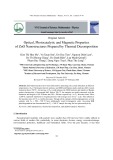
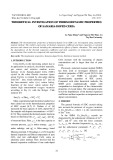
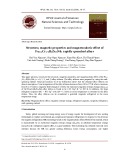


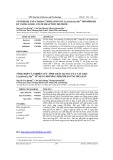









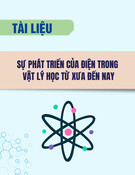
![Bộ câu hỏi lý thuyết Vật lý đại cương 2 [chuẩn nhất/mới nhất]](https://cdn.tailieu.vn/images/document/thumbnail/2025/20251003/kimphuong1001/135x160/74511759476041.jpg)
![Bài giảng Vật lý đại cương Chương 4 Học viện Kỹ thuật mật mã [Chuẩn SEO]](https://cdn.tailieu.vn/images/document/thumbnail/2025/20250925/kimphuong1001/135x160/46461758790667.jpg)




